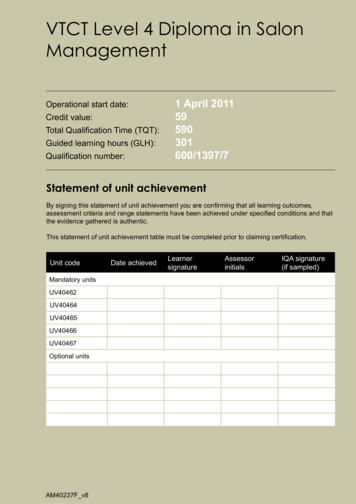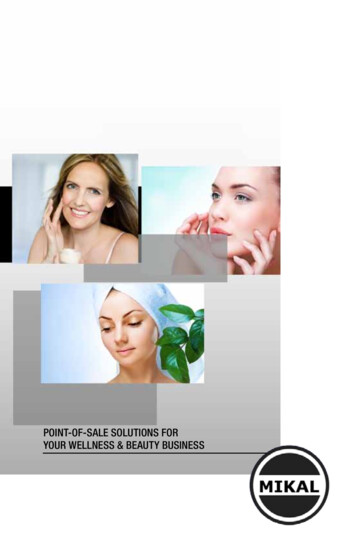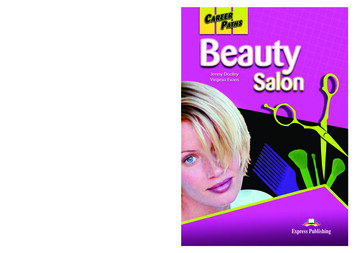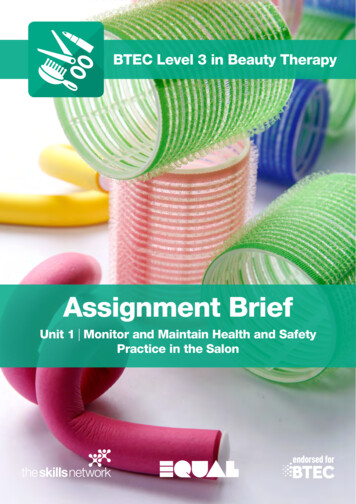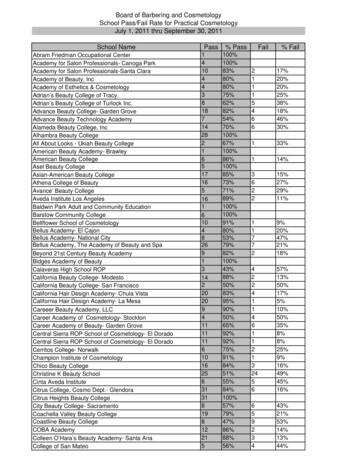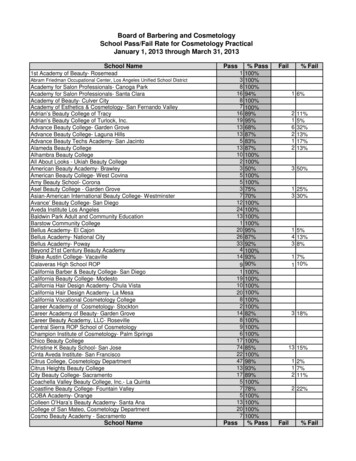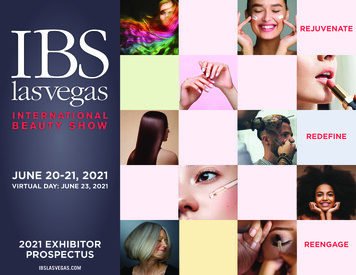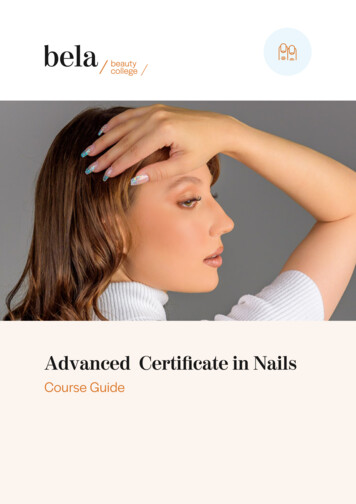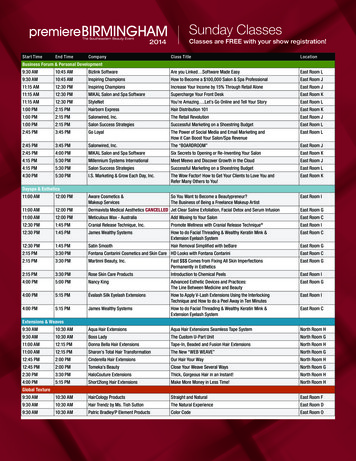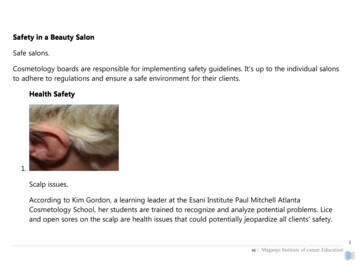
Transcription
Safety in a Beauty SalonSafe salons.Cosmetology boards are responsible for implementing safety guidelines. It's up to the individual salonsto adhere to regulations and ensure a safe environment for their clients.Health Safety1.Scalp issues.According to Kim Gordon, a learning leader at the Esani Institute Paul Mitchell AtlantaCosmetology School, her students are trained to recognize and analyze potential problems. Liceand open sores on the scalp are health issues that could potentially jeopardize all clients' safety.1sc Maganjo Institute of career Education
Tool Safety2.Scaly feet.Within recent years, the Georgia Board of Cosmetology has taken steps to reduce the chances ofinjury or infections by banning nippers and credo blades. Credo blades scale off dry skin duringpedicures, while nippers cut extra skin around the cuticle.Sanitization3.2sc Maganjo Institute of career Education
Disinfect.Gordon says after a single use, hair stylists and beauticians must put all their used implements intoa labeled container for dirty implements. A sanitizing process with an EPA-registered, hospitalgrade disinfectant must place at the end of each day.Speculation4.Overexposed.Concerns over exposure to ammonia from hair dyes and exposure to electric magnetic fields (EMF)-- from too many blow-dryers running at the same time -- have not been substantiated by OSHA.3sc Maganjo Institute of career Education
Complaints5.Gordon says if you have any safety concerns about your neighborhood salon, a complain must befiled in writing to your State Cosmetology Board.Safety Rules in the SalonAccording to the book "Professional Beauty Therapy," salons are legally obligated to provide a safe andhygienic working environment for their customers and staff. Paying special attention to safety andhealth ensures the welfare of customers. Salon clients must be served in sanitary conditions.Licensing1. In the United States, salons must receive a license from their states before they can beginoperating. This ensures that they are compliant with certain safety regulations.sc Maganjo Institute of career Education4
Sanitation2. One of the main concerns for many salons is sanitation. Proper sanitation keeps customers andstaff safe and avoids health problems and infections. Salons must properly clean and disinfect theirequipment to practice good sanitation.Toxins3. In nail salons, improper ventilation can pose a health risk to clients and workers by increasing thelevels of toxicity in the air. Salons must ensure that their ventilation system provides fresh air intakeand exhaustion of stale air. This will reduce the clients' and staff's exposure to airborne bacteria,particles, and toxic vapors.Contagious Illness4. In many states, individuals who have a contagious or infectious disease are not allowed to work asa nail technician or cosmetologist. Individuals who are contagious have the capacity to infect salonclients, which is illegal.Procedures5. Many states have banned the use of razors in pedicures. Scraping the customer's feet with a razorposes a danger to health because it has the potential to remove healthy skin and raises the risk ofinfections and rashes. Salon staff must also sanitize all sinks, bowls, and boards for each newcustomer.5sc Maganjo Institute of career Education
Considerations6. According to "Newsweek," there are certain things that an individual can do to ensure that they aregoing to safe salon. They should first make sure the salon is licensed and that their technician iscertified. Patrons should also consider taking their own tools when they go in for a pedicure ormanicureHAIRDRESSING/BEAUTY SALONSIrritant dermatitis occurs when a substance physically Damages the skin. Shampooing can set this offbecause Frequent contact removes the protective oils, thus drying the skin. Fortunately, the effects canbe reversible by taking Suitable precautions, such as the wearing of gloves.Allergic contact dermatitis is more serious and is irreversible. It occurs when a person has beenexposed to a sensitizing agent, possibly over a long period of time before any reaction is noticed.Sensitising agents include some of the chemicals used in hair preparations. Once sensitised, the allergicreaction occurs extremely quickly when exposed to the substance subsequently. To avoid contact withsensitising agents it is therefore again important to use gloves and to follow product instructionscarefully.6sc Maganjo Institute of career Education
SKIN PIERCINGBeauty salons may offer electrolysis or ear piercing, both of which require registration with the localauthority under the Local Government (Miscellaneous Provisions) Act 1982 and, if Appropriate,compliance with byelaws made under the Act. Health and safety considerations are dealt with in moredepth in the Skin Piercing element of this manual. In summary, the main Requirements are to usesuitable equipment, to follow Recommended methods, to have good standards of personal andEnvironmental hygiene, to have well-trained operators and to keep records of all skin piercingtreatments.WAXINGHot and warm wax may be used for depilation but it should never be filtered and reused. A disposablespatula should be used to apply the wax to the skin and then discarded. Spatulas should not be putback in the pot of wax once they have been in contact with the skin. There are propriety systems forwaxing that remove the risk of contamination of the wax. Good personal hygiene should be observedat all times.HAIRDRESSINGSolid open razors should not be used, except those with disposable blades. Electric razors should beavoided unless adequate cleansing and sterilisation can be ensured. Clippers, when used, should beproperly aligned with the bottom blade in front of the top blade by approx 1/16". Equipment should beregularly cleansed and sterilised as necessary, e.g. if a client’s skin has been cut.7sc Maganjo Institute of career Education
ELECTRICAL EQUIPMENTAdvice on the safety of electrical equipment is contained elsewhere in this manual. The range, numberand 'portability' of electrical equipment used in salons, together with their proximity to water, make forpotentially hazardous situations.In summary, appropriate precautions would include establishing an electrical equipment register andtest/checking system, visual checks by staff, protective devices (including a residual current device fittedto circuits to which portable hand tools are connected) and earth bonding of pipework.ULTRA VIOLET TANNING EQUIPMENTIn summary, precautions would include the safe construction, installation and maintenance of theequipment, ensuring safe working practices so as to limit client exposure and suitable training of staff.Further details can be found in the Radiation element of this manual.SLIP AND TRIP HAZARDSThese may arise from trailing cables, loose hair or liquid spillage. They require either prevention in thefirst place (trailing cables) or prompt attention should they arise during working.SPACE HEATINGAny space heaters used should be suitably located and guarded - bear in mind children and clients’clothing8sc Maganjo Institute of career Education
Bacteria controlthings have changed and continue to change; as communicable diseases change and mutate, as newchemical agents are created and tested, sanitation standards also must evolve. But fear not it’s allgood.You must be doing something right when you are rating at a 100% for fifteen years. Each state has theirown sanitation rules and regulations but some things are universal. Allow me to reiterate your goodsalon sanitation habits.9sc Maganjo Institute of career Education
Here are some pointers concerning contagious disease.Always do:*remember that a communicable disease is transmitted from one person to another.*Pus is a sign of infection.*Aids is caused by the HIV virus and can be transmitted by sharp implements.*Bacteria and viruses can enter the body through broken skin.If you or any of your associates come across a client that may have a contagious disease, do notperform any service and do not try to medicate or diagnose, always refer your client to a physician.Here are some sanitation pointers:*Removing pathogens and other substances from tools or surfaces is called decontamination.*All disinfectants must be approved by each individual state and the EPA.*Every product used in the salon should have a MSDA (material safety data sheet).*A disinfectant that is formulated for hospitals and normally used in salons must besc Maganjo Institute of career Education10
pseudomonacidal, bactericidal, fungicicdal, and virucidal.*Clean all implements before soaking in any disinfectant.*Mix disinfectants with water and change them once a day.*Always store clean and disinfected implements in a clean and covered container.*Wash your linens and drapes in bleach and store them in a dry, clean and covered place.*Disinfect your tools and implements after each client.sc Maganjo Institute of career Education11
How to Clean Pedicure StationsBy MiMi Abney, eHow Contributing WriterIf not properly sanitized, the pedicure station in a salon is a haven for nasty bacteria. In fact, accordingto the Centers for Disease Control and Prevention (CDC), a dirty pedicure station can affect all salonpatrons negatively by spreading Mycobacterium fortuitum through a foot bath. To prepare the safestpedicure possible for your clients---and prevent microorganisms from entering the skin---a manicuristmust clean and disinfect her pedicure station thoroughly after each customer. Without a carefulcleansing and daily disinfection procedure, pedicure basins become the breeding grounds for thespread of athlete's foot, nail fungus and bacterial infections.Things You'll Need: EPA-registered liquid disinfectantChelating agentPaper towelsSmall disinfected scrub brushBarbicide1. Step 1sc Maganjo Institute of career Education12
Drain the water from the foot tub after each pedicure service. According to the EnvironmentalProtection Agency (EPA) and the CDC, "a foot spa should be disinfected between each customer,and nightly."2. Step 2Scrub the pedicure tub completely. Combine liquid soap and warm water in the foot basin. Allowthe sudsy water to remain in the tub for five to seven minutes. Using a brush disinfected withbarbicide, scrub the inside of the basin vigorously to remove any remaining dirt or nail clippings.3. Step 3Drain the water from the tub. Rinse several times with water to remove any soap residue. Wipe thetub clean with a paper towel.4. Step 4Begin sterilization. Combine the EPA-registered liquid disinfectant with warm water in the footbasin. Allow the mixture to soak for 10 minutes. Drain the tub completely. Rinse the tub severaltimes with warm water. Use a clean paper towel to dry the pedicure station.5. Step 5At the end of each day, clean and sterilize all removable parts of the pedicure station. Remove thescreen at the back of the whirlpool basin or air jet foot bath. Clean the screen and the removablesc Maganjo Institute of career Education13
parts using a disinfected brush and warm, soapy water. Dry and replace the cleaned parts andscreen.6. Step 6Combine a chelating agent with warm water in the foot basin for five to 10 minutes. Turn on thetub. Allow the solution to circulate through the jets to clean the pedicure station. Repeat Step 4 tosterilize the tub using the EPA-registered disinfectant.sc Maganjo Institute of career Education14
Use of Antiseptics & DisinfectantsBy Veronica Romualdez, eHow Contributing WriterCleaning with antiseptics and disinfectantsDisinfectants and antiseptics are germicidal solutions, also known as sanitizers and antimicrobials, andare used to quickly kill bacteria on contact. The difference between the two is that disinfectants are usedto kill bacteria on objects and surfaces while antiseptics are used to kill bacteria on skin or living tissue.Disinfectants and antiseptics are used everywhere from hospitals to homes to destroy harmfulmicroorganisms.Different Types of Disinfectants1. Different types of disinfectants include alcohols, aldehydes, bleaches, hydrogen peroxide, iodineand potassium permanganate solution. Phenol compounds, which are disinfectants used in handwashes and soaps, are also used for their anti-bacterial properties.sc Maganjo Institute of career Education15
Use of Disinfectants2. Disinfectants are used in many different places such as in hospitals, clinics, homes, schools andoffices. They are used to clean surfaces such as toilets, sinks, floors, drains, door knobs, countersand garbage cans. Disinfectants aid in maintaining a clean environment to help prevent the spreadof harmful bacteria that may cause infections.Different Types of Antiseptics3. Different types of antiseptics include alcohol, boric acid, hydrogen peroxide, iodine, carbolic acid,chlorohexadine, sodium chloride, sodium hypochlorite and calcium hypochlorite. Additionally,phenol compounds are also used as antiseptics such as in mouthwashes.Use of Antiseptics4. Antiseptics are applied to the skin either to sterilize a cut or used for hand-washing such as beforea surgical procedure or contact with those who are at a high risk of infection such as newbornbabies. Antiseptics destroy and inhibit the growth of microorganisms on the skin or mucousmembranes. They are not as strong as disinfectants, so they shouldn't be used to clean objects andsurfaces.Regulatory Agencies5. The use of disinfectants is regulated by the Environmental Protection Agency (EPA) Office ofPesticides. They require manufacturers to test the product's stability, toxicity to humans andmicrobial activity before being distributed and sold. Germicides that are used in the medicalsc Maganjo Institute of career Education16
environment are regulated by the Food and Drug Administration (FDA). Specific informationabout microbial activity is submitted by the manufacturers before being distributed and sold. TheFDA also regulates the use of antimicrobial soaps, scrubs and wound protectors.Germicidal Effectiveness6. The effectiveness of germicides is based on a number of factors. Such factors include the shape ofthe object being cleaned, its texture and whether it is flat or cracked. The amount of microbes andthe resistance of these microbes to the germicide also play a part in its effectiveness. The amountof blood, mucus or tissue on the skin affects the effectiveness of antiseptics, as do the chemicalcomposition, time of exposure and temperature of the germicide. It is for this reason thatgermicidal solutions should be used for its specific purpose and used properly based on themanufacturer's instructions.Disinfectants (definitions and formsDisinfectants are substances that play a big role in maintaining safe environments, foods, chemicals andwaters. The antisepsis strength of disinfectants varies and is determined by health and governmentorganizations using standardized tests.There several health benefits of disinfectant, such as prevention of surgical equipment contamination,elimination of crop pests and maintenance of water potability. However, using disinfectants beyond theestablished safety level may also bring unwanted effects because disinfectants are chemical substancesthat destroy cellular organisms.sc Maganjo Institute of career Education17
Definition1. A disinfectant or antiseptic is a chemical substance that kills or prevents growth of microorganismssuch as disease-causing bacteria.According to "Guideline for Disinfection and Sterilization in Healthcare Facilities" by Rutala andWebber, "Disinfection is a process that eliminates many microorganisms with the exception ofbacterial spores." In other words, disinfectants doesn't sterilize or completely eliminate bacteria atonce.History2. The first known application of disinfectant dates back to 1865 when British surgeon Joseph Listerused carbolic acid to disinfect wounds, such as open wounds from accidents or during surgicaloperations. Thereafter, experts have invented numerous disinfectants such as antibacterial mouthwash, Listerine, which was named after Dr. Lister.Identification3. The antisepsis factor of a disinfectant may be measured in terms of disinfectant strength. Thisfactor is different in every disinfectant, for instance, the disinfectant strength of an alcohol differsfrom that of a hand sanitizer. The difference between disinfectant strengths is due to the varyingconditions of the standard tests used in evaluating the disinfectant. For instance, the targetedbacteria in a certain standard test is more difficult to kill than other test targets.sc Maganjo Institute of career Education18
Benefits4. Disinfectants, if used properly and in the right amounts, offer a wide array of health benefits. Thecommon benefits include elimination of bacteria from wounds, prevention of infectious diseases,prevention of food contamination, elimination of pests in crops, ensuring the potability of waterand maintaining safe pool water.sc Maganjo Institute of career Education19
According to Kim Gordon, alearning leader at the Esani Institute Paul Mitchell Atlanta Cosmetology School, her students are trained to recognize and analyze potential problems. Lice and open sores on the scalp are health issues that could potentially jeo pardize all clients' safety.
